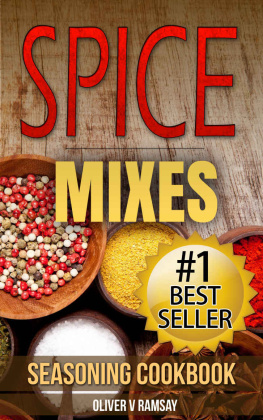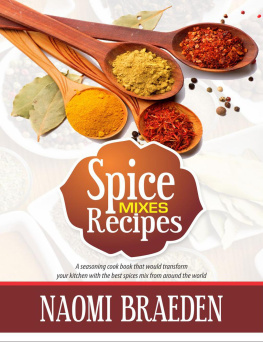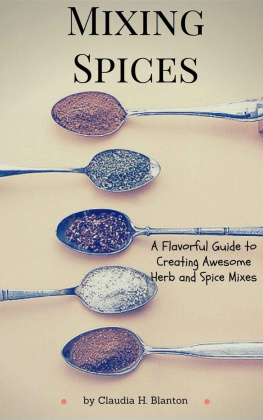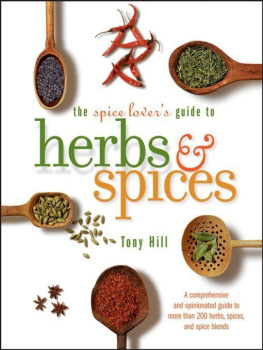One way or another you have likely been in this scenario: you have prepared a meal to the best of your ability and you have followed all the instructions properly, but when you consume the food, you realize that it was only the first few bites that tasted any good. As you indulge, the food loses taste and you realise that it really is quite bland. You then ask yourself: what did I do wrong? Were the ingredients I chose not fresh enough? Did I over cook the food? No matter how much analyse your cooking methods, you know that you did the right steps!; so why doesnt the food taste delicious?
When you reviewed everything and you are satisfied that you didnt mess up with either the ingredients or the instructions, then the reason why the food wasnt as delicious as it was supposed to be is likely because of the lack of flavoring used in the food.
Dont worry! You can easily remedy the problem the next time you cook! All you need to do is gather a few spices, herbs and condiments. With these, you can create different spice mixes and seasonings to enhance the flavor of any given meal.
First things first, though: what are spice mixes? A spice mix is a blend of different herbs, spices, and condiments. They are great if you want to add more flavor to your meal, give your food a fuller taste or simply to shake things up a little bit so youre not eating the same thing every time! You can usually purchase them at your local grocery store, but if you want your recipe to be more personal, you may mix them yourself. Mixing your own spices is almost always less expensive and it allows you to create the perfect personalised blend.
Well, thankfully you have purchased this book; consider your problem, solved! This book contains specific instructions on how to mix the herbs and spices, so you wont feel lost. Well also give you guidance on how you can personalise spices to your own taste!
If youre already a pro at spices and spice mixes then this book is also for you. Then this book will still be a great companion as we share over 40 Spice mix recipes from all around the world . Each mix will have a suggestion on what type of meals they can be used for and how they will enhance the flavour of the food. There will also be useful tips in mixing spices, and storing them.
Thanks a lot for downloading this book, and I can assure you that this will be a great kitchen companion for years to come!
Chapter 1: A Brief History of Spices
You have likely seen reddish or brownish powders in the local grocery store selling spices. Some look fresh while some have an ancient look. Most of the time they seem quite uninteresting; however over the years spices have inspired war, exploration, trade as well as poetry since the dawn of civilization. Believe it or not, the ground pepper that dresses our salad today was once upon a time as valuable as gold; the nutmeg that we consume, was the cause of a war in which England which gained Long Island!
Spices have been of immense significance to mankind since historys beginning. They are mentioned in the Old Testament, the Bagavad Gita and the Epic of Gilgamaesh. Archaeologists discovered spices recently, which date back as early as 3000 BC, in Egyptian tombs. The strong preservative feature of several spices was ideal for use in the embalming process carried out in these times.
A large number of the spices in ancient times were strongly affiliated or connected to different Gods. So, apart from the embalming qualities, the fragrance of the spices was also believed to hold the favor of the Gods, rendering a better opportunity to receive celestial help while traveling into the afterlife. Across periods of history, the mystical properties of the spices have drawn attention, either through smoking or ingesting.
Spices have been there since the start of hieroglyphic practice. In Crete, in the palace of Knossos, a wall depicts a man or a monkey picking saffron, which is a very precious spice. The carving has been done around 1700 BC.
With the progress of civilization, record keeping became more complex. A mesmerizing document known as the Ebers Papyrus, dated 1550 B.C., explains medicinal and surgical practice during the time. Now we have a listing of a range of cures from spices and herbs, a number of these are the same spices and herbs we normally house for our everyday cooking in our own spice racks. Most probably, the most significant aspect of spices in the past was the capability of healing and perpetuating life.
Another factor that explains the significance of spices is their contribution to the exploration of the planet. We were not satisfied with the spices that had been cultivated in the back yards, but desired to explore unfamiliar territories. As far as adventure travel was concerned, the peril was huge, but the rewards too were awesome. They came in the shape of spices, ebony, ivory, silver, gold, new plant forms and rare animals. As the traveling capability of humans enhanced, the discovery of exotic and new lands took a new turn.
Man always seeks to chase the unobtainable, and the lucky ones who acquired the valuable commodities became affluent men, men of royalty, nobility, church officials with high rank, and some became clever and shrewd businessmen and merchants. It must be noted that although spices were flavorful and exotic and sure to lead to new culinary worlds, the main reason for humans seeking spices was their medicinal use. Even in the recent 1500s, when the Spice Wars were rampant between the Dutch and the Portuguese and afterwards the Dutch and the English, nutmegs were already precious. The reason was not the desire of the Queen for a new dessert, but the belief that nutmeg could miraculously cure plague, which caused the death of over 35,000 people in London in the year1603.
Apart from being the source of many mens fortunes, during a number of periods, spices were literally considered as currency. In Judea, Pharisees paid tithes in the form of cumin seeds. In the fifth century, when Alaric the Visigoth seized Rome, the ransom constituted 3000 pounds worth of peppercorns. In 14 th century in Germany, seven FAT oxen could be traded for a pound of nutmeg. In history, there are also instances of rent being paid in peppercorns. Moreover, in medieval France, a serfs freedom could be bought in exchange for a pound of pepper.
While analyzing the history of spices, it has been found that almost each and every spice was considered to be a potent aphrodisiac. Culpepper, the renowned English herbalist prescribed ginger for those who did not fare well in the sports of Venus. When Cortez discovered vanilla in Mexico and brought back the same to Europe, an extensive study was conducted by a German doctor to scientifically reach the conclusion that vanilla cured male impotence. Spices across the ages were also held high for their role in healthy dieting.
Due to its essences, some merchants dared to become unscrupulous: they take fake spices and sell them as if they are genuine. However, there is a certain time phase in which spice merchants trading in false saffron were caught and burned at the stake along with the false saffron.
During those times when water was not that accessible to people, spices became substitute for bathing. After returning from battling, when knights met their king, they would sit on the ground which was scattered with fresh rosemary or thyme. Almost every wealthy king would have stunning maidens sprinkling the most precious of spices, saffron, over him and he walked across the stairway of the palace event.









